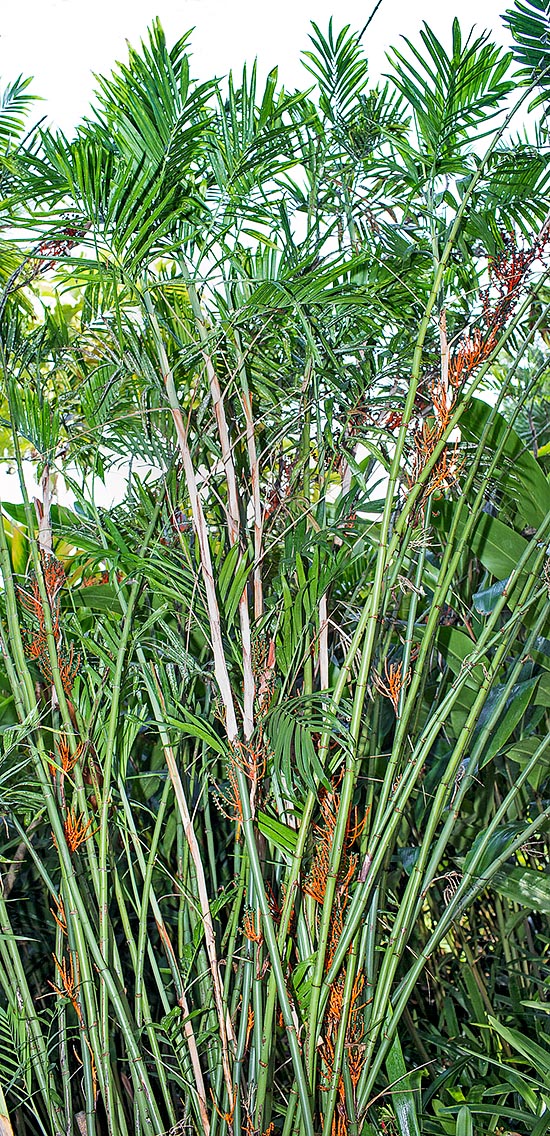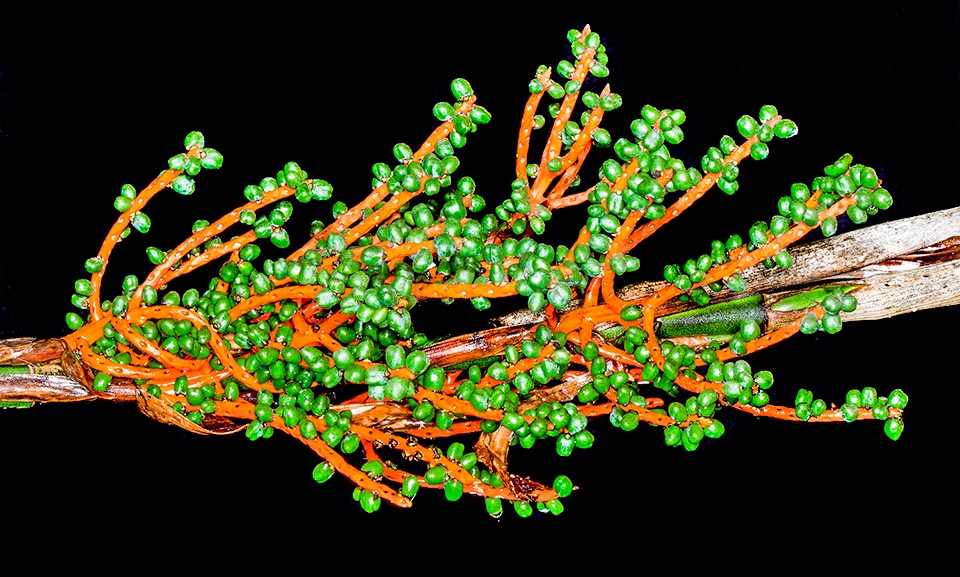Family : Arecaceae

Text © Pietro Puccio

English translation by Mario Beltramini

Chamaedorea seifrizii is native to Belize, Guatemala, Honduras and Mexico © Giuseppe Mazza
The name of the genus is the combination of the Greek adverb “χαμαί” (chamai) = on the ground, on the soil, and of the substantive “δωρέα” (doréa) = gift, the German botanist Carl Ludwig Willdenow (1765-1812), who created the genus in 1806, did not specify the exact meaning of the name. The species is honoured to its collector, the American biologist and botanist of German origin, William Seifriz (1888-1955).
Common names: bamboo palm, reed palm (English); xaté, xiat (Belize and Guatemala).
The Chamaedorea seifrizii Burret (1938) is a dioecious species fairly variable forming dense tufts with erect or slightly inclined stems, 1,8-2,5 m long and of 1-2 cm of diameter, of glossy intense green colour on which are visible the whitish rings of the foliar scars spaced of 12-20 cm. The leaves, on a 8-12 cm long petiole, are pinnate, 35-50 cm long, with 10-16 alternate or sub-opposite leaflets regularly arranged on both sides of the rachis, linear-lanceolate to slightly sigmoid with pointed apex, 20-35 cm long and 1-2,5 cm broad, of glossy intense green colour. The tubular foliar base, obliquely open at the apex, of pale green colour, wraps totally the stem for a length of 25-30 cm, persisting dried for long time.
Inflorescences, on a 4-8 cm long peduncle, under the leaves (infrafoliar), erect, ramified, the male ones with drawn near flowers of green colour, of about 3 mm of diameter, spirally arranged on the rachillae, the female ones with yellow flowers, of 2-3 mm of diameter, rather spaced and spirally arranged on the rachillae, initially green, then orange when in fruit.
Globose fruits, of about 0,8 cm of diameter, black when ripe, that may aver irritant when touched and toxic if ingested due to the presence of crystals of calcium oxalate.
It reproduces by seed in draining loam maintained humid at the temperature of 26-28 °C, with rather variable and long germination times, starting from 1-2 months, if fresh, up to 9-12 months, and by division on late spring-early summer.
Already cultivated by the Mayas, it is perhaps the species most utilized of the genus, and from more time, even if with different names, together with the Chamaedorea elegans, for the decoration of inner spaces, thanks to its sturdiness and adaptabillity to different conditions of cultivation and to a certain degree of neglect.
As garden plant is nowadays diffused in all countries with tropical, subtropical and marginally temperate warm climate, where it can resist, with damage to the foliage, to temperatures up to -3 °C, provided exceptional and short lasting. It stands the full sun as well as the shade and is not particular about the soil, provided draining, maintained constantly humid, even if, well rooted, stands short dry periods. In pot, for having a lush appearance, it is better to utilize a perfectly draining loam rich of organic substance, with regular and abundant waterings during the growth period, but without stagnations, more spaced in winter, in order to allow the substratum to partially dry up before giving water again.

Even 2,5 m tall tufts. Emerald green fruits in elegant contrast to the orange red rachillae. They blacken ripening and contain toxic crystal of calcium oxalate © G. Mazza
Synonyms: Chamaedorea donnell-smithii Dammer (1905); Meiota campechana O.F.Cook (1943); Chamaedorea erumpens H.E.Moore (1951).
→ For general notions about ARECACEAE please click here.
